Common Causes for Yellowish Soybean Leaves
July 18, 2023
Introduction
Many conditions can cause a soybean crop to become prematurely yellow. Premature yellowing is otherwise known as chlorosis. Chlorosis is the result of a reduction in chlorophyll production; yellow carotenoid pigments become visible in the absence of the green chlorophyll pigments.
KEY POINTS: What are some of the causes that can turn a of soybean crop prematurely yellow?
- Nutrient deficiency: yellow soybean leaves can be caused by a nutrient deficiency, most notably nitrogen (N), iron (Fe), potassium (K), or manganese (Mn).
- Disease: premature yellowing can be caused by several common soybean diseases. Some of these diseases include sudden death syndrome (SDS), brown stem rot (BSR), stem canker, and white mold.
- Soybean cyst nematode (SCN): another potential cause for soybeans turning yellow.
- Herbicide injury: many herbicide injuries including those caused by ALS inhibitors, atrazine, and HPPD inhibitors can cause a soybean crop to turn yellow.
- Restricted root growth: any condition that restricts root growth (such as compaction layers, extremely wet or dry soil, insects, disease, etc.) can lead to temporary nutrient deficiencies and soybean yellowing, because the roots cannot reach sufficient levels of nutrients in the soil to sustain normal growth and development.
- Lightning Injury: small, circular yellow areas can be caused by lightning injury.
Nutrient deficiencies
Nitrogen Deficiency
Nitrogen (N) deficiency appears as chlorosis (yellowing) of the lower leaves of the canopy as the plant remobilizes N from older leaves to support new growth (Figure 1).
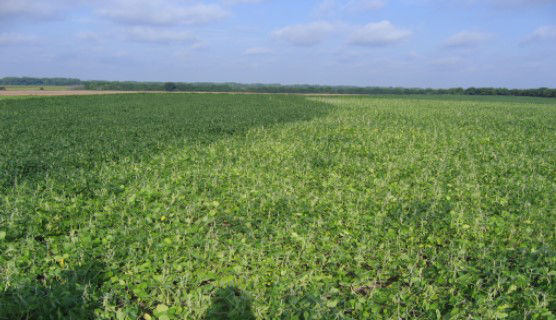
Even with adequate native rhizobia levels in the soil, nitrogen deficiency can occur in soybean planted into fields that have been extremely dry or that have been water saturated for an extended period.1 These conditions not only slow soybean root development, limiting access to nitrates in the soil, but can also reduce populations of the rhizobia bacteria that live in the soil and in soybean nodules. This can create a situation where the rhizobia levels might not be sufficient to develop the active nodules needed to provide the N required for normal plant development. Sometimes soybean leaves can appear light green during nodule formation, due to a lack of sufficient N in the soil.
Management options: Most university guidelines suggest inoculating soybean with rhizobia if it has been more than three to five years since soybean was last grown in the field to insure adequate levels of the bacteria. Once nodules begin producing adequate amounts of N, the normal dark-green color should return. If soybeans fail to nodulate properly, as can occur in fields with insufficient populations of rhizobia bacteria, a rescue N application may help preserve yield potential.
Iron Deficiency
Iron (Fe) is a nutrient necessary for photosynthesis, nodule formation, and many metabolic processes within the plant. The distinctive symptom of iron deficiency is yellowing of the leaves while the veins remain green (interveinal chlorosis; Figure 2), which is the result of low chlorophyll formation. Iron-deficiency symptoms typically appear on the uppermost, youngest leaves between the first and third trifoliate growth stages. This condition is referred to as iron deficiency chlorosis (IDC).
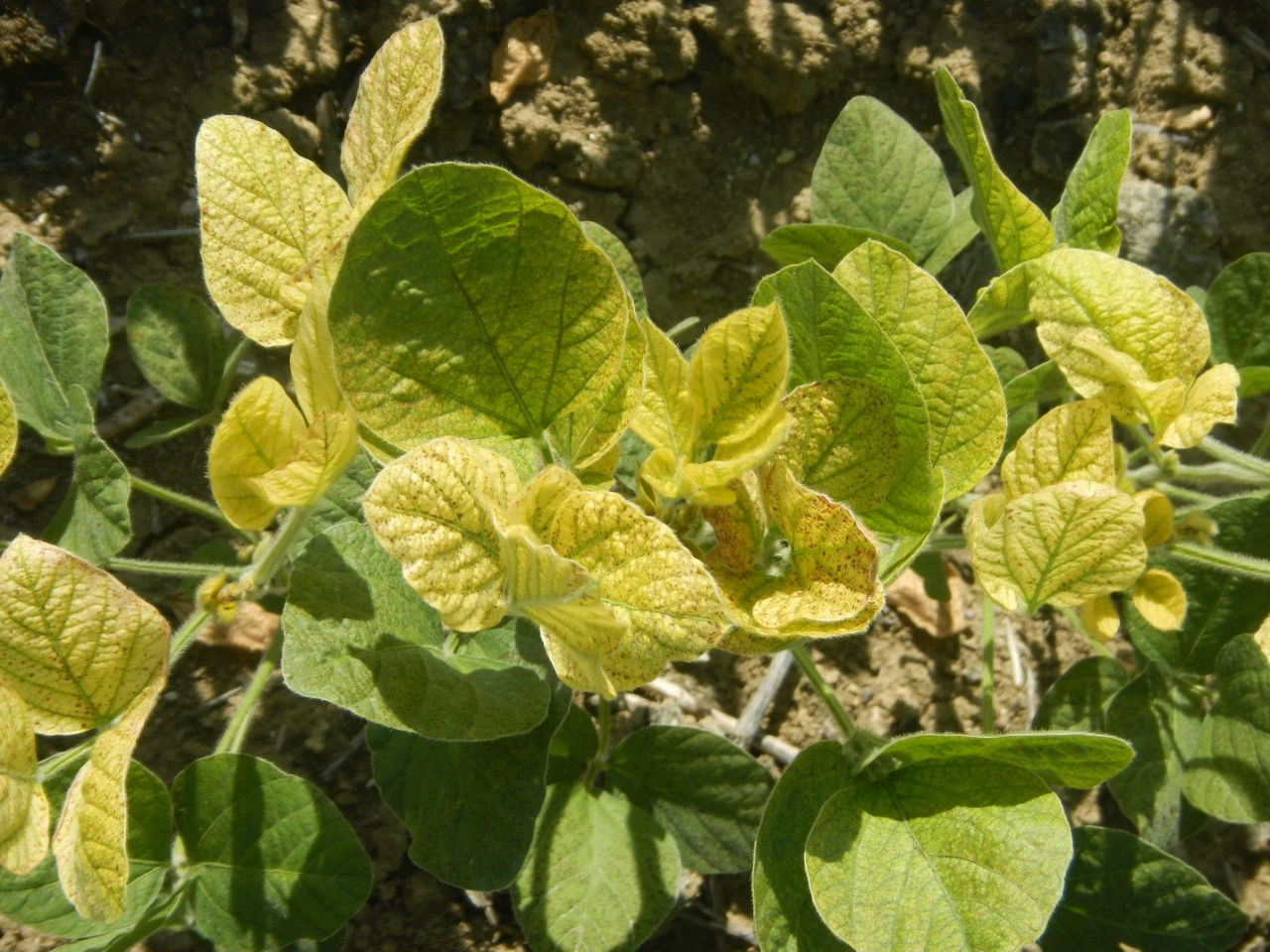
Iron deficiency most commonly occurs when the iron in the soil is biologically unavailable to the plants due to a high soil pH, and not simply when iron levels are low in the soil. IDC is often associated with shallow depressions in a field or with low-lying areas where water stands due to poor drainage. These areas can have elevated levels of free lime, salts, and nitrate. Iron deficiency can also show up in areas where the topsoil has been eroded, exposing the subsoil and causing a high pH due to high levels of free lime (calcareous soil). IDC may also show up in soybean if growing conditions cause poor nodulation.2
Management options: The most important management option is the use of soybean products tolerant to IDC. Chelate iron products that carry the ortho-ortho-EDDHA Fe chelate form can also be applied in-furrow in affected areas of the field at seeding to improve the plants’ access to iron.2
Potassium deficiencies
Potassium (K) deficiencies can occur due to restricted root growth or insufficient K levels in the soil. Potassium is mobile in the plant and deficiencies will first appear as yellowing along the edges of the oldest leaves (Figure 3). This condition can intensify and spread up the plant as the deficiency worsens. With severe deficiencies, the leaf edges may become brown, and affected plants will appear stunted.
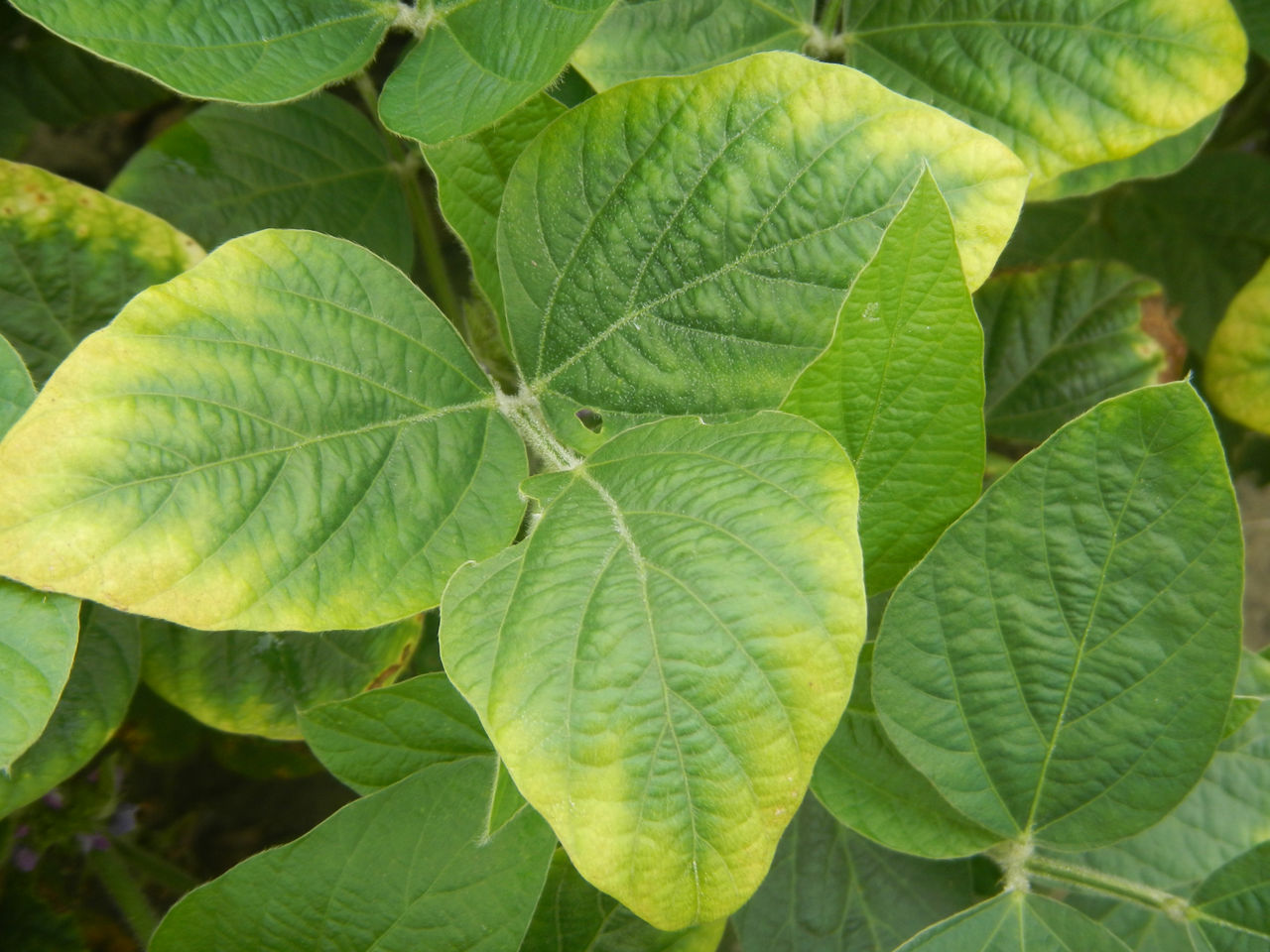
Management options: If the deficiency is due to inadequate K levels in the soil, a rescue application of K can be made by broadcasting potassium chloride (potash, 0-0-60) with sufficient rainfall or irrigation to move the fertilizer into the soil. This may help protect yield potential.
Common soybean diseases that cause premature yellowing
Sudden death syndrome, brown stem rot, stem canker, and charcoal rot can all cause foliar symptoms. Chemical burn can also cause similar foliar symptoms, but examination of the roots of chemically burned plants would show a healthy root system, which is often not the case with pathogen-caused yellowing.
Sudden death syndrome
Sudden death syndrome (SDS) is a soil-borne fungal disease that prefers cool, moist environments. It invades the roots and lower stem of soybean plants.3 Early symptoms of SDS infection include areas of leaf yellowing between the veins that eventually die and turn brown. Diseased leaves may cup or curl and then drop from the plant (Figure 4).
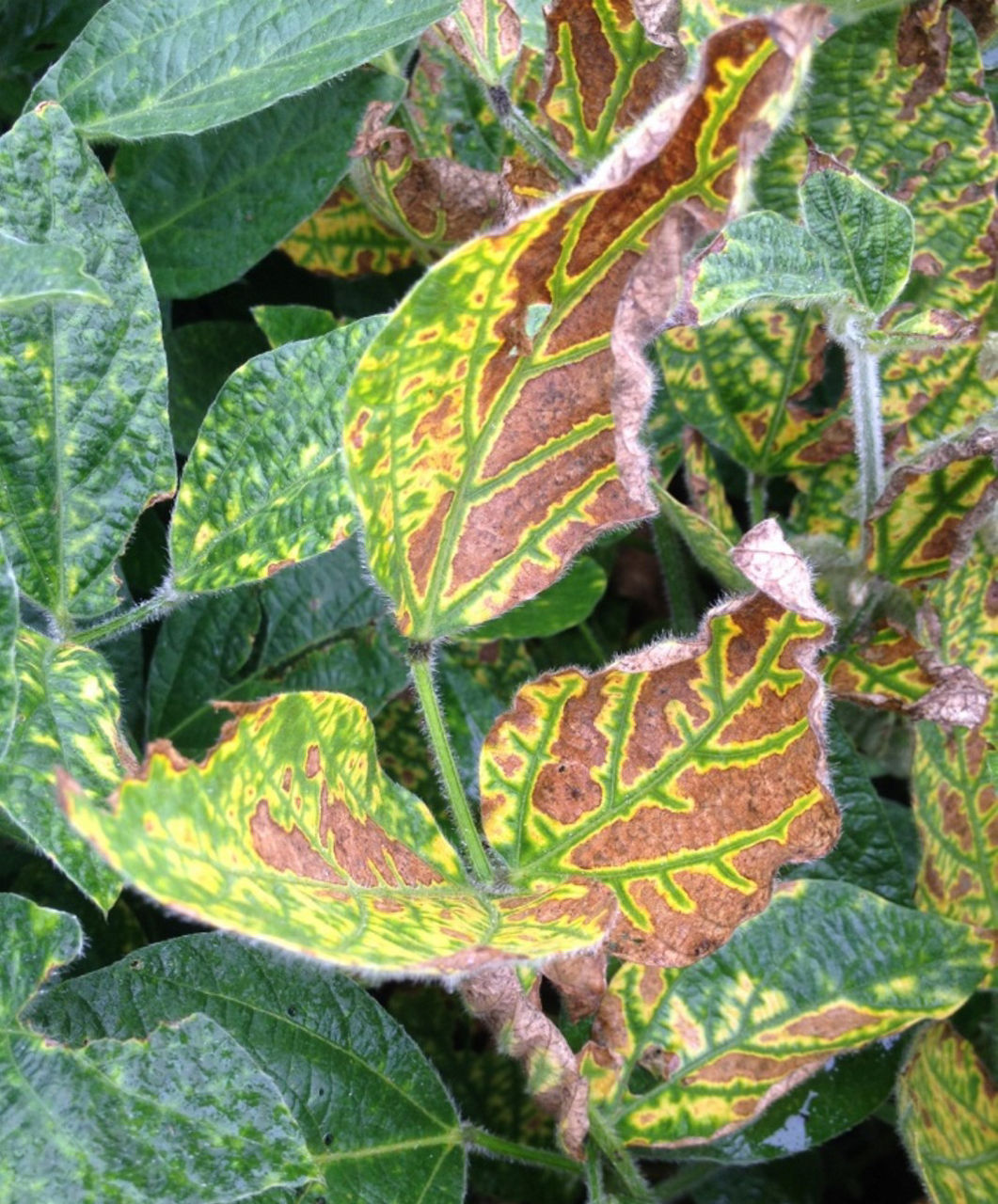
Management options: The number one management option is to use varieties of soybean with SDS resistance. In fields with recurring SDS, soil compaction should be avoided or reduced, and soil drainage should be improved. Proper pH and fertility levels should also be maintained. SDS is not affected by rotation.3
Brown stem rot (BSR)
BSR is also a soil-borne fungal disease that prefers a cool, moist environment. Infection occurs early in the season and symptoms appear around mid-August or later.3 Characteristic BSR foliar symptoms include chlorosis and premature death of leaf cells between leaf veins, followed by leaf curling and death.

Management options: The most important management options for BSR are the use of resistant soybean varieties and rotation to non-host crops such as corn. Because soybean cyst nematodes may interact with BSR, the use of a variety with resistance to soybean cyst nematodes may also help to reduce the occurrence of BSR.4
Stem canker
Stem canker can kill whole plants or parts of plants and can be confused with Phytophthora rot. Foliage of diseased plants initially exhibits interveinal yellowing, often followed by leaf tissue death between the veins. There are two distinct types of stem canker known as the northern stem canker and southern stem canker. This disease often appears to kill or damage scattered plants, but in some cases large areas can be killed and yield losses can be significant. Fields which have had hail damage have often been observed to have more stem canker problems.
Management options: The best way to manage stem canker is to plant resistant soybean varieties. Rotating crops to wheat or corn and incorporating infested crop residue into the soil will reduce the amount of inoculum available to infect the next soybean crop. Properly timed foliar fungicides can be beneficial as well.
White mold
White mold, also known as Sclerotinia stem rot, can be a significant problem in the northern soybean growing region. This fungal disease produces white, fluffy, cottony growth on the outside of the stem and on the pods (Figure 6).
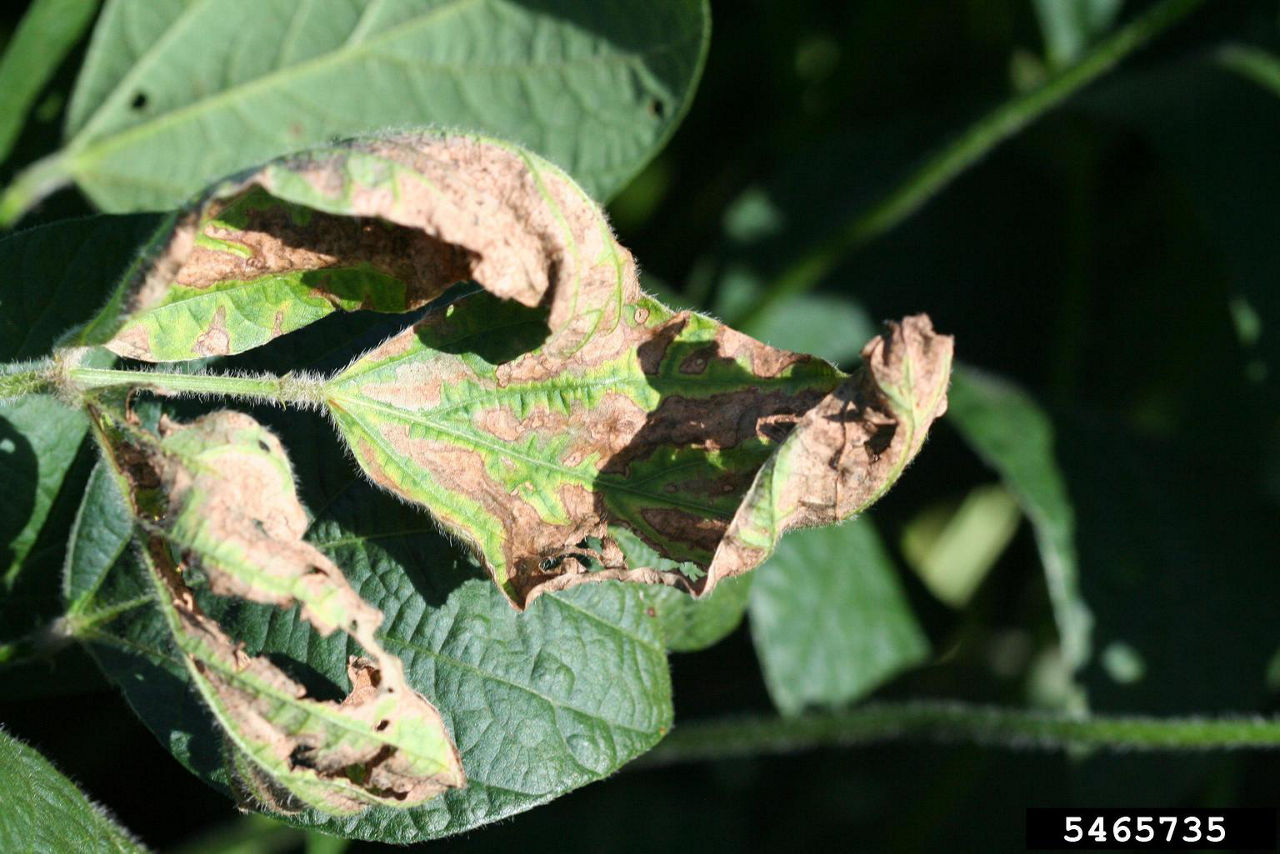
Management options: Management options should be based on field history and should integrate several management tactics, including selecting a soybean product with white mold tolerance. In low to moderate disease-pressure environments, cultural practices can reduce white mold damage. These include rotating to non-host crops and using wide row spacing with lower plant populations to increase air flow through the canopy and reduce shading. Chemical control options can help reduce disease occurrence when used at the early bloom growth stage (R1) through when pods are 3/16 to 3/4 inch long (R3), as this disease infects plants through dying blooms.
Soybean Cyst Nematode
Serious infestations of soybean cyst nematodes (SCN) can cause yellowing in soybeans, often in circular patches in the infested areas (Figure 7). SCN attacks the root system, making the plant more susceptible to soil borne diseases such as SDS and BSR.3 In addition, infested plants will often be stunted. SCN infestations reduce the plant’s ability to access nutrients and water and to tolerate stress, so the environmental effects of nutrient deficiencies or drought stress may be amplified in SCN-infested fields.

Management options: Soil sampling can be used to determine if SCN is present in your fields. SCN resistant soybean varieties are available; however, resistance to these genes has been identified in some growing regions, which highlights the importance of rotating between resistant gene offerings. Crop rotation to a non-host crop such as corn, small grains, sorghum, and alfalfa is also an option, though it may take three or more years of rotation to a non-host crop to reduce nematodes egg numbers to sub-economic levels.5
Yellowing caused by restricted root growth
Soil compaction is one of the most common causes of restricted root. Compacted layers of soil reduce aeration, water, and nutrient uptake, which can cause a soybean crop to have stunted growth and to turn yellow. Soil compaction is often caused by field traffic, heavy machinery use, or tillage—especially under when machinery is used in wet soil conditions.
Soil compaction can often appear in a field as a hardpan layer which can restrict root growth. A hardpan can be identified by digging up and looking at the root systems of soybean plants in an area with prematurely yellow plants. A root system that roots down several inches before the tap root takes off in a lateral direction can indicate that the roots hit a hardpan. Roots that are unable to grow through the hardpan will continue to grow parallel to the it.
Management options: One of the most common ways to correct a hardpan or otherwise compacted soil is for the producer to use deep tillage to break up the compacted soil. This is often done by using a tillage implement the works soil deeper than the hardpan, such as a deep soil ripper. This should be done when the soil is dry to break the compacted soil into soil clods. Moisture will then be required to soak and break down the dirt clods to a consistency that plant roots can penetrate. Alternatively, if the producer does not want to use tillage, crops with large taproots can be used to loosen compacted soils. Some cover crops mixtures include turnips or sunflower which can help correct a hardpan, if the hardpan is not too hard or too thick.
Yellowing in soybean caused by herbicide injury
There are many ways that a soybean crop may be yellowed by herbicide injury. This includes exposure to herbicide carryover from a previous crop, herbicide drift, or herbicide leaf burn, often due to a high-rate herbicide application. These injuries can be made worse if the surfactants load is increased. Injury can often be seen after a labeled application is applied during less-than-ideal early growth conditions, which can cause the soybean to have reduced early growth vigor.
Yellow Flash
One type of leaf burn is known as yellow flash. Yellow flash can sometimes occur when a post-emergence application of a high rate of glyphosate is done under stress conditions. Symptoms of yellow flash include yellowing of the newest leaves at the top of the plant while the older leaves remain green, which can look like Manganese deficiency. Yellow flash generally occurs on plants that were already stressed (temperature or drought) when the glyphosate was applied, and may be more common at the edges of fields and in spray-overlapped areas where application rates can be two to three times the intended rate.
Management options: Affected soybean leaves often return to their normal color within a week after the application with little, if any, growth reduction. If the soybean plants were not properly growing due to stressful conditions when glyphosate was applied, yellowing may not occur for 10 to 21 days. If conditions were dry when yellowing occurred, these leaves may remain yellow until the crop resumes growth after rain or irrigation.
HPPD [HG] 27 and clomazone [HG] 13 injuries on soybean
HPPD-inhibiting herbicides and [HG] 13 herbicides are referred to as bleachers. Bleachers inhibit plant pigment synthesis, resulting in chlorosis and/or bleaching of the soybean leaf. The effects of this bleaching can range from just the leaf margins to the entire leaf. This type of injury can be caused by herbicide carryover or by herbicide drift. HPPD is mobile in the plant, so injury will show up on the new leaf growth. Clomazone herbicide can be applied to the crop pre-emergence, but under some conditions can cause bleaching.
Management options: Carryover injury can be reduced if the labeled rates are used and plant-back restrictions are followed. Avoid any overlapping applications which can cause a two to three times the intended rate of herbicide to be applied to a plant. Physical drift can be avoided by spraying when the average wind speed is less than 10 miles an hour, and by avoiding mid-day or afternoon applications to minimize the occurrence of a temperature inversions. The injury caused by HPPD and clomazone are almost identical, but clomazone injury will subside with time (Figure 8). 6
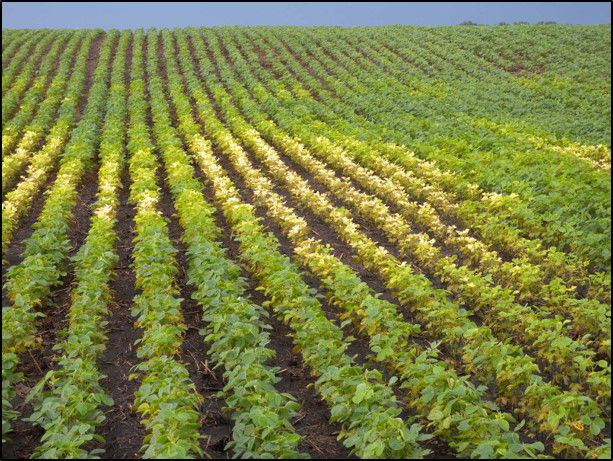
Yellowing in soybean caused by lighting injury
Lightning damage tends to occur to a circular area of plants. Plants within this area tend to experience sudden, uniform wilting, or their leaves may appear scorched.7 Plant death is usually relatively consistent, with damage diminishing near the border of the impacted area.
Management options: Usually, lightning damage occurs in areas small enough to not justify major management action. However, be sure to rule out other pathogens and nematodes as the source of the injury, as these causes might produce similar damage patterns.
Conclusion
There are many pests, pathogens, fertility deficiencies, herbicide injuries, and other growing conditions that can cause a soybean crop to turn prematurely yellow. Some of the common causes and conditions have been discussed here, but there are many additional culprits that can cause these symptoms. To complicate this issue further, many of the symptoms can look very similar. So, making a conclusive determination as to the cause of the yellowing may take some additional effort. Confirming the condition turning your crop yellow may require sending a sample to a laboratory for disease testing, taking soil or leaf samples to have analyzed for nutrient deficiencies, or utilizing other seed or crop experts in your area. Only once the problem is identified can the proper steps be taken to help correct the yellowing problem, and only after the problem is corrected can the soybean crop’s maximum yield potential be achieved.
Sources
1Davidson, D. 2016. Agronomy: yellowing of soybeans. Illinois Soybean Association. ILSoyAdvisor. https://www.ilsoyadvisor.com/agronomy-yellowing-soybeans/.
2Franzen, D.W. 2019. Soybean soil fertility. North Dakota State University. https://www.ndsu.edu/agriculture/ag-hub/publications/soybean-soil-fertility.
3Noticing yellow soybeans. 2020. University of Illinois Urbana-Champaign. College of Agriculture, Consumer and Environmental Sciences. https://extension.illinois.edu/blogs/good-growing/2020-08-20-noticing-yellow-soybeans
4Malvic, D. 2018. Brown stem rot (BSR) on soybeans. University of Minnesota Extension. https://extension.umn.edu/pest-management/brown-stem-rot-bsr-soybean.
5Faghihi, J. and Ferris, V.R. 2018. Soybean cyst nematode. Purdue University. Extension Entomology. https://extension.entm.purdue.edu/publications/E-210/E-210.html.
6Everman, W. and Jones, E. 2020. HPPD and clomazone injury on soybean. North Carolina State Extension Publication. https://content.ces.ncsu.edu/hppd-and-clomazone-injury-on-soybean#:~:text=The%20HPPD%2Dinhibiting%20herbicides%20inhibit,the%20entirety%20of%20the%20leaf.
7 Strunk, K., Clark, J. and Bly, A. 2022. What is causing soybeans to yellow at this time? South Dakota State University Extension. https://extension.sdstate.edu/what-causing-soybeans-yellow-time.
Web sources verified 06/29/23. 1313_58891